All portable air conditioners come with exhaust hoses or they wouldn’t function. Evaporative coolers are an excellent hoseless alternative to portable air conditioners for cooling a space, but remember, they only cool a person and might increase the humidity of the space.
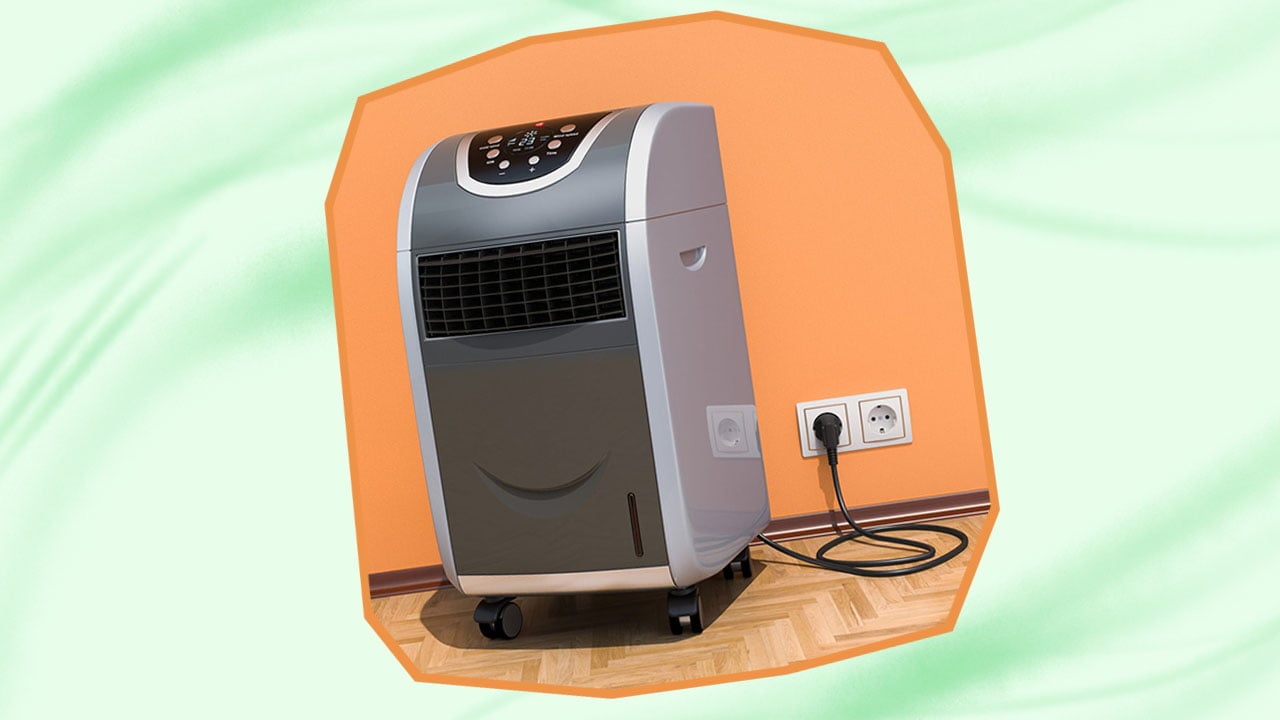
Do you know what portable air conditioners are– they are self-contained units that can be set up in any corner of a room. But though convenient, most people find the exhaust hose troublesome.
While there’s no shortage of portable air conditioners, a portable AC unit with a vent hose is better. That’s because exhaust hoses expel humid air while bringing in the fresh air, so today, I’ll discuss the importance of exhaust hoses in portable AC units.
Is There A Portable Air Conditioner Without Hose
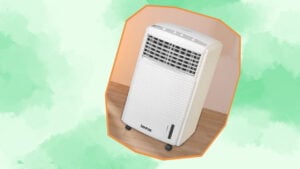
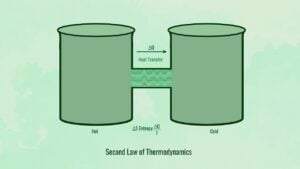
A portable air conditioning system without an exhaust hose would surely be an excellent choice for rooms with limited floor space.
Compared to traditional portable air conditioners, a portable AC without a vent hose is relatively easy to set up and aesthetically appealing. On top of that, such units do not produce as much noise as the traditional ones. Less noise means you’ll more likely be able to focus on your work or sleep better than you would otherwise.
Sadly, there’s no such thing as portable AC units without a hose– meaning, an air conditioning system without a hose is just a pipedream. Without a venting system, a portable AC won’t function because no heat exchange would occur, as per the 2nd law of the Thermodynamics principle.
How Traditional Portable Air Conditioners Work?
Using negative pressure flow, portable air conditioners cool a space with the AC extracting warm air and lowering the temperature via the condenser coil and compressor. Then, it releases cool air into the space to make it cozy and comfortable.
More or less, the components of a portable air conditioner are similar to that of window units. They are as follows:
- Condenser coils
- Compressor
- Fan
- Evaporator coils
- Exhaust hose
The refrigerant gas in the system is converted into a high-pressure vapor by the compressor. Later, the vapor is cooled by the condenser coils and changed into liquid form.
Further, this liquid moves across the evaporator coils. Subsequently, the cool air is blown into the room via the fan, while exhaust hoses, usually attached to the rear of portable air conditioners, expel the warm air outdoors.
Why is a Hose Needed For Portable Air Conditioners?
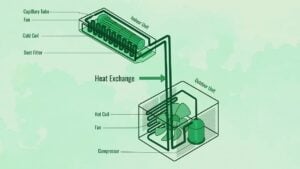
I’d like to mention that the exhaust hose is in no way an extra feature; rather, it’s an essential component of portable air conditioners.
The primary function of exhaust hoses is to direct warm air from a room outdoors while drawing in fresh and cool air and dispersing it indoors. Without exhaust hoses, this heat transfer wouldn’t be possible.
Even if you try running your portable units without exhaust hoses, it won’t decrease the indoor temperature but will increase it. In case of a portable air conditioner, the outdoor space has to be hotter only then will the indoor area be cooler.
A hoseless portable AC would run in a single insulated space; further, the exchange of heat from indoors to outdoors wouldn’t be facilitated in the absence of a hose. Therefore, your space won’t get cooled no matter how long you run the unit.
In conclusion, portable air conditioners without hoses don’t exist, and you can never use a portable air conditioner without attaching the hose.
Alternatives To Portable Air Conditioners With Hose
No portable air conditioner can cool a space without exhaust hoses. Nevertheless, there are 2 alternatives to such air conditioners, and they are as follows:
1. Vent The Portable AC Without A Window
Portable AC units need not necessarily be vented through the windows, despite being among the most common venting options. In spaces where there are no windows, you can vent the unit through a dryer vent, wall, door, attic, and so on.
2. Use A Ventless Portable Air Conditioner
Quite similar to traditional portable air conditioners, ventless portable AC units cool a space without being vented. That makes them an ideal option for places with no windows and hey are also known as evaporative coolers.
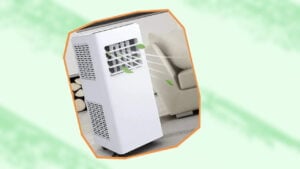
Hoseless Ventless Air Conditioners
A ventless air cooler, also known as an evaporative cooler or swamp cooler, is basically an HVAC (heating, ventilating, and air conditioning) system that provides a cooling effect.
And since it isn’t equipped with a refrigerant or a compressor, you will have to fill the tank with ice or water. That’s because it runs on evaporative cooling technology– a principle based on water evaporation.
To understand how swamp coolers provide a cooling effect, you must understand the 2 basic Thermodynamic features.
1. Evaporative Cooler Cools A Person Not The Room
One of the first things you need to understand is that evaporative coolers produce cool air via natural water evaporation. What that means is they do not have a refrigerant cycle as is the case with portable AC units. You need to place the air cooler towards you to enjoy the cooling effect.
2. Swamp Coolers Heat The Room
While they do a decent job of keeping people cool, you need to keep in mind that they heat the space they run in. This happens because an evaporative cooler doesn’t have an exhaust hose to transfer heat, so the wattage is the only thermodynamic input.
Not just that, but the natural inefficiency of the unit is also responsible for heating the space. Because of the heat loss, the temperature of the room increases, thereby warming the room.
Advantages And Disadvantages Of Traditional Portable Air Conditioners
Now that I’ve covered the basics, I’ll move on to discuss the pros and cons of owning a traditional portable air conditioner. So, let’s check them out!
Pros
1. Ideal For Small Spaces And Rental Apartments
For spaces up to 500 square feet, installing a window unit or central air conditioning wouldn’t be the right choice. A portable AC unit will be an excellent addition because it doesn’t occupy much space.
Even in rental apartments where residents aren’t allowed to install a water cooler or any other equipment, a portable AC will help you stay cool in the scorching summer heat.
2. Easy To Move
Almost all portable AC units come with caster wheels and boast a compact design, so movement isn’t much of an issue with these units. A few models on the market also feature a built-in handle for easy portability.
3. Hassle-Free Setup
With a portable AC unit, you can save a few dollars on professional installation because they are ready to use right out of the box. Without any professional tools, such ACs can be set up in less than 30 minutes– connect the exhaust hose, plug it into an electrical outlet, and that’s it!
4. Relatively Easy On The Pockets
Since portable AC units don’t cost a bomb, even people on a shoestring budget can afford them. What’s even better is that they are moveable, so you need not invest in multiple ACs for various rooms of your home. Best of all, the majority of the units found on the market are energy-efficient, so you won’t have to worry about mounting utility bills.
Cons
1. Unwanted Noise
One of the significant downsides of portable ACs is that they generate loud noises when running. Rarely a few units operate at 40 dB, but the noise output of most portable ACs is 57 dB to 59 dB.
2. Low Capacity
If you think you can install a portable AC unit in a large room, you’re wrong! That’s because portable AC units aren’t as high capacity as a window or ductless system. Instead, they come with a maximum capacity of 14,000 BTU, which can cool a space of 400 to 500 square feet.
How To Choose A Portable Air Conditioner Without Hose
With everything at your disposal, are you ready to take the leap and bring home a portable air conditioner without a hose? Well, then, don’t forget to keep these factors in mind when choosing because they’ll help you in the decision-making process.
1. Size Of The Room
Among all the factors, the most important is the size of the room where you’ll use the evaporative cooler.
That’s because swamp coolers come in varying cooling capacities, and the floor space plays an important role in determining which one would work well. After determining the size, you will have to calculate the CFM (cubic feet per minute) rate to know the airflow volume.
To figure out the CFM rate, simply calculate the square footage of the area and divide the answer by 2. The answer that comes is the CFM capacity you should go for to cool your space efficiently.
2. Check The Fan
Evaporative coolers are equipped with either an axial fan or a centrifugal fan. While the former uses less energy, it generates a loud noise. On the other hand, the centrifugal fan is a drum-shaped fan that operates quietly but consumes a lot of energy.
3. Look Whether A Remote Control Is Supplied
If not all, the majority of swamp coolers come with remote control. Convenience is the biggest reason to invest in such models because you’ll be able to control the temperature even from a distance.
4. Check If The Louvers Are Adjustable
Earlier, evaporative coolers didn’t come with adjustable louvers. But today, the majority of them come with adjustable louvers. This way, the stream of air is redirected from the unit into whichever direction you adjust it to.
In basic models, the louvers can be adjusted only up and down, but they can be set in varying directions in the high-end models. All in all, I’d say that investing in a high-end swamp cooler will be worth it, even if that means spending a bit more.
Tip
Not every swamp cooler is made of high-quality materials. You wouldn’t want to bring home a cooler made of flimsy materials, as the construction of the unit determines its longevity. Always go for options made of stainless steel, marine-grade aluminum, polypropylene, or polyethylene plastics because they are durable and built to last.
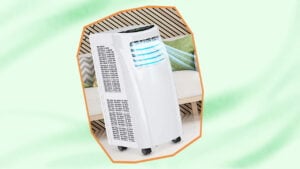
Summing It Up
Each and every portable air conditioner on the market requires a hose to function efficiently, so there’s no way you can go against the laws of physics.
While you can vent it without a window, one of the obvious solutions is to invest in a ventless air conditioner. That’s because ventless air conditioners can deliver a cooling effect without the inconvenience of a vent hose; not to forget, they are easy on the pockets.
However, remember, they warm the space they run in. When deciding on a ventless air conditioner, keep the factors mentioned above in mind, and I’m sure you’ll make a sound decision!
